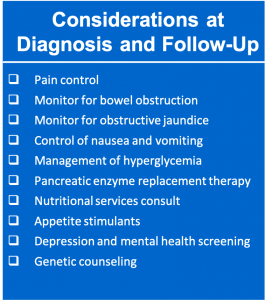SUMMARY: The American Cancer Society estimates that in 2023, about 64,050 people will be diagnosed with Pancreatic cancer and 50,550 people will die of the disease. Pancreatic cancer is the fourth most common cause of cancer-related deaths in the United States and Western Europe. Unfortunately, unlike other malignancies, very little progress has been made and outcome for patients with advanced Pancreatic cancer has been dismal, with a 5-year survival rate for metastatic Pancreatic cancer of approximately 10%. Pancreatic cancer has surpassed breast cancer as the third leading cause of cancer death in the United States and is on track to surpass colorectal cancer, to move to the second leading cause of cancer related deaths in the United States. Majority of patients with Pancreatic cancer (80% of cases) are diagnosed at an advanced stage, and are not amenable to curative surgical resection, at the time of diagnosis. The current treatment regimens for advanced disease have proved ineffective, conferring a median Overall Survival (OS) of 6-8 months.
ONIVYDE® is a novel nanoliposomal encapsulation of Irinotecan, a topoisomerase 1 inhibitor. It is designed to optimize the delivery of Irinotecan, by extending the duration of circulation of the drug in the body and preferentially activating the drug within the tumor tissues, to achieve higher levels of the active cytotoxic drug metabolite, SN-38. This approach reduces the toxicity of Irinotecan to normal tissues while maintaining or increasing its anti-tumor efficacy.
In the NAPOLI-1 open-label Phase III study, a combination of ONIVYDE®, 5-FU and Leucovorin improved Overall Survival, Progression Free Survival, CA19-9 response and Disease Control Rate following Gemcitabine-based therapy, in patients with metastatic Pancreatic adenocarcinoma. ONIVYDE® in combination with Fluorouracil (5-FU) and Leucovorin was approved for this indication in 2015. In a Phase I/II study, ONIVYDE® in combination with 5-FU, Leucovorin and Oxaliplatin (NALIRIFOX) demonstrated promising anti-tumor activity in patients with metastatic Pancreatic ductal adenocarcinoma.
NAPOLI 3 is a global, randomized, open-label Phase III trial which tested the safety and efficacy of NALIRIFOX regimen in treatment naïve patients with metastatic Pancreatic ductal adenocarcinoma. In this study, 770 patients with histopathologically/cytologically confirmed untreated metastatic Pancreatic ductal adenocarcinoma were randomized in a 1:1 ratio to receive NALIRIFOX (N=383) or Gemcitabine plus nab-Paclitaxel (N=387). The NALIRIFOX regimen consisted of ONIVYDE® 50 mg/m2 IV, given along with 5-FU 2400 mg/m2 IV, Leucovorin 400 mg/m2 IV and Oxaliplatin 60 mg/m2 IV on days 1 and 15 of a 28-day cycle. Patients in the Gemcitabine/nab-Paclitaxel group received Gemcitabine 1000 mg/m2 IV along with nab-Paclitaxel 125 mg/m2 IV, on days 1, 8 and 15 of a 28-day cycle. Both treatment groups were well balanced with similar baseline characteristics, including median age of 64.5 years and number of metastatic sites (three or greater in 37% of patients). Approximately 80% of patients had liver metastases. Patients were stratified by ECOG performance status, geographic region, and presence or absence of liver metastases. The Primary endpoint was Overall Survival (OS) and Secondary endpoints included were Progression Free Survival (PFS), Overall Response Rate (ORR) and Safety.
At a median follow-up of 16.1 months, the median OS was 11.1 months in the NALIRIFOX group versus 9.2 months in the Gemcitabine plus nab-Paclitaxel arm (HR=0.83; P=0.04). The 12 months OS rate was 45.6% versus 39.5%, and 18 months OS rate was 26.2% versus 19.3% respectively. There was also a significant improvement in the PFS at 7.4 months versus 5.6 months respectively (HR=0.69; P=0.0001). The 12 months PFS rate was 27.4% versus 13.9%, and 18 months PFS rate was 11.4% versus 3.6% respectively. This OS and PFS benefit was observed across subgroups.
The NALIRIFOX group also had a higher Objective Response Rate at 41.8% versus 36.2% for patients treated with Gemcitabine and nab-Paclitaxel group, and the median Duration of Response was 7.3 months versus 5.0 months respectively. A lower percentage of patients who received NALIRIFOX went on to receive subsequent anticancer therapy (50.5% versus 54.4%). Treatment related toxicities associated with NALIRIFOX regimen were manageable and included a higher incidence of diarrhea, nausea and hypokalemia.
It was concluded that first-line treatment with NALIRIFOX regimen demonstrated clinically meaningful and statistically significant improvement in Overall Survival and Progression Free Survival, compared with Gemcitabine and nab-Paclitaxel, in treatment-naïve patients with metastatic Pancreatic ductal adenocarcinoma.
Liposomal irinotecan + 5-fluorouracil/leucovorin + oxaliplatin (NALIRIFOX) versus nab-paclitaxel + gemcitabine in treatment-naive patients with metastatic pancreatic ductal adenocarcinoma (mPDAC): 12- and 18-month survival rates from the phase 3 NAPOLI 3 trial. O’Reilly EM, Melisi D, Macarulla T, et al. J Clin Oncol. 2023;41(suppl 16):4006. doi:10.1200/JCO.2023.41.16_suppl.4006


